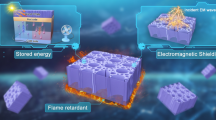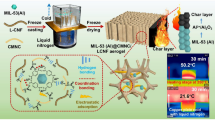Abstract
The achievement of both robust fire-safety and mechanical properties is of vital requirement for carbon fiber (CF) composites. To this end, a facile interfacial strategy for fabricating flame-retardant carbon fibers decorated by bio-based polyelectrolyte complexes (PEC) consisting of chitosan (CH) and ammonium polyphosphate (APP) was developed, and its corresponding fire-retarded epoxy resin composites (EP/(PEC@CF)) without any other additional flame retardants were prepared. The decorated CFs were characterized by SEMEDX, XPS and XRD, indicating that the flame-retardant PEC coating was successfully constructed on the surface of CF. Thanks to the nitrogen- and phosphorous-containing PEC, the resulting composites exhibited excellent flame retardancy as the limiting oxygen index (LOI) increased from 31.0% of EP/CF to 40.5% and UL-94 V-0 rating was achieved with only 8.1 wt% PEC. EP/(PEC8.1@CF) also performed well in cone calorimetry with the decrease of peak-heat release rate (PHRR) and smoke production rate (SPR) by 50.0% and 30.4%, respectively, and the value of fire growth rate (FIGRA) was also reduced to 3.41 kW·m–2·s–1 from 4.84 kW·m–2·s–1, suggesting a considerably enhanced fire safety. Furthermore, SEM images of the burning residues revealed that the PEC coating exhibited the dominant flame-retardant activity in condensed phase via the formation of compact phosphorus-rich char. In addition, the impact strength of the composite was improved, together with no obvious deterioration of flexural properties and glass transition temperature. Taking advantage of the features, the PEC-decorated carbon fibers and the relevant composites fabricated by the cost-effective and facile strategy would bring more chances for widespread applications.
Similar content being viewed by others
References
Yang, X. L.; Li, K.; Xu, M. Z.; Liu, X. B. Designing a phthalonitrile/benzoxazine blend for the advanced GFRP composite materials. Chinese J. Polym. Sci. 2017, 36(1), 106–112.
Nunna, S.; Creighton, C.; Fox, B. L.; Naebe, M.; Maghe, M.; Tobin, M. J.; Bambery, K.; Vongsvivut, J.; Hameed, N. The effect of thermally induced chemical transformations on the structure and properties of carbon fibre precursors. J. Mater. Chem. A 2017, 5(16), 7372–7382.
Xu, Y. J.; Wang, J.; Tan, Y.; Qi, M.; Chen, L.; Wang, Y. Z. A novel and feasible approach for one-pack flame-retardant epoxy resin with long pot life and fast curing. Chem. Eng. J. 2018, 337, 30–39.
Shen, D.; Xu, Y. J.; Long, J. W.; Shi, X. H.; Chen, L.; Wang, Y. Z. Epoxy resin flame-retarded via a novel melamine-organophosphinic acid salt: thermal stability, flame retardancy and pyrolysis behavior. J. Anal. Appl. Pyrolysis 2017, 128, 54–63.
Li, W. W.; Kang, H. L.; Xu, J.; Liu, R. G. Effects of ultra-high temperature treatment on the microstructure of carbon fibers. Chinese J. Polym. Sci. 2017, 35(6), 764–772.
Xu, M. J.; Xia, S. Y.; Liu, C.; Li, B. Preparation of poly(phosphoric acid piperazine) and its application as an effective flame retardant for epoxy resin. Chinese J. Polym. Sci. 2018, 36(5), 655–664.
Liao, D. J.; Xu, Q. K.; McCabe, R. W.; Babu, H. V.; Hu, X. P.; Pan, N.; Wang, D. Y.; Hull, T. R. Ferrocene-based nonphosphorus copolymer: synthesis, high-charring mechanism, and its application in fire retardant epoxy resin. Ind. Eng. Chem. Res. 2017, 56(44), 12630–12643.
Rajaei, M.; Wang, D. Y.; Bhattacharyya, D. Combined effects of ammonium polyphosphate and talc on the fire and mechanical properties of epoxy/glass fabric composites. Ind. Eng. Chem. Res. 2017, 113, 381–390.
Xu, Y. J.; Chen, L.; Rao, W. H.; Qi, M.; Guo, D. M.; Liao, W.; Wang, Y. Z. Latent curing epoxy system with excellent thermal stability, flame retardancy and dielectric property. Chem. Eng. J. 2018, 347, 223–232.
Agrawal, S.; Narula, A. K. Synthesis, characterization of phosphorus containing diamide-diimide-tetraamines based on L-tryptophan amino acid and their effect on flame retardancy of epoxy resins. Chinese J. Polym. Sci. 2014, 32(2), 197–208.
Aschberger, K.; Campia, I.; Pesudo, L. Q.; Radovnikovic, A.; Reina, V. Chemical alternatives assessment of different flame retardants-A case study including multi-walled carbon nanotubes as synergist. Environ. Int. 2017, 101, 27–45.
Curran, I. H.; Liston, V.; Nunnikhoven, A.; Caldwell, D.; Scuby, M. J.; Pantazopoulos, P.; Rawn, D. F.; Coady, L.; Armstrong, C.; Lefebvre, D. E. Toxicologic effects of 28-day dietary exposure to the flame retardant 1,2-dibromo-4-(1,2- dibromoethyl)-cyclohexane (TBECH) in F344 Rats. Toxicology 2017, 377, 1–13.
Liao, S. F.; Deng, C.; Huang, S. C.; Cao, J. Y.; Wang, Y. Z. An efficient halogen-free flame retardant for polyethylene: piperazinemodified ammonium polyphosphates with different structures. Chinese J. Polym. Sci. 2016, 34(11), 1339–1353.
Jian, R.; Wang, P.; Duan, W.; Wang, J.; Zheng, X.; Weng, J. Synthesis of a novel P/N/S-containing flame retardant and its application in epoxy resin: thermal property, flame retardance, and pyrolysis behavior. Ind. Eng. Chem. Res. 2016, 55(44), 11520–11527.
Rao, W. H.; Xu, H. X.; Xu, Y. J.; Qi, M.; Liao, W.; Xu, S.; Wang, Y. Z. Persistently flame-retardant flexible polyurethane foams by a novel phosphorus-containing polyol. Chem. Eng. J. 2018, 343, 198–206.
Sun, J.; Yu, Z.; Wang, X.; Wu, D. Synthesis and performance of cyclomatrix polyphosphazene derived from trispirocyclotriphosphazene as a halogen-free nonflammable material. ACS Sustain. Chem. Eng. 2013, 2(2), 231–238.
Wang, W.; Wen, P.; Zhan, J.; Hong, N.; Cai, W.; Gui, Z.; Hu, Y. Synthesis of a novel charring agent containing pentaerythritol and triazine structure and its intumescent flame retardant performance for polypropylene. Polym. Degrad. Stab. 2017, 144, 454–463.
Wang, X.; Zhou, S.; Guo, W. W.; Wang, P. L.; Xing, W.; Song, L.; Hu, Y. Renewable cardanol-based phosphate as a flame retardant toughening agent for epoxy resins. ACS Sustain. Chem. Eng. 2017, 5(4), 3409–3416.
Du S. L.; Lin X. B.; Jian, R. K.; Deng C.; Wang Y. Z. Flameretardant wrapped ramie fibers towards suppressing “candlewick effect” of polypropylene/ramie fiber composites. Chinese J. Polym. Sci. 2015, 33(1), 84–94.
Tai, Q.; Hu, Y.; Yuen, R. K. K.; Song, L.; Lu, H. Synthesis, structure-property relationships of polyphosphoramides with high char residues. J. Mater. Chem. 2011, 21(18), 6621–6627.
Jiang, S.; Shi, Y.; Qian, X.; Xu, H.; Lo, S.; Gui, Z. Synthesis of a novel phosphorus- and nitrogen-containing acrylate and its performance as an intumescent flame retardant for epoxy acrylate. Ind. Eng. Chem. Res. 2013, 52(49), 17442–17450.
Tan, Y.; Shao, Z. B.; Chen, X. F.; Long, J. W.; Chen, L.; Wang, Y. Z. Novel multifunctional organic-inorganic hybrid curing agent with high flame-retardant efficiency for epoxy resin. ACS Appl. Mater. Interfaces 2015, 7(32), 17919–17928.
Tan, Y.; Shao, Z. B.; Yu, L. X.; Xu, Y. J.; Rao, W. H.; Chen, L.; Wang, Y. Z. Polyethyleneimine modified ammonium polyphosphate toward polyamine-hardener for epoxy resin: Thermal stability, flame retardancy and smoke suppression. Polym. Degrad. Stab. 2016, 131, 62–70.
Tan, Y.; Shao, Z. B.; Yu, L. X.; Long, J. W.; Qi, M.; Chen, L.; Wang, Y. Z. Piperazine-modified ammonium polyphosphate as monocomponent flame-retardant hardener for epoxy resin: flame retardance, curing behavior and mechanical property. Polym. Chem. 2016, 7(17), 3003–3012.
Li, C.; Kang, N. J.; Labrandero, S. D.; Wan, J.; González, C.; Wang, D. Y. Synergistic effect of carbon nanotube and polyethersulfone on flame retardancy of carbon fiber reinforced epoxy composites. Ind. Eng. Chem. Res. 2013, 53(3), 1040–1047.
Hu, S.; Song, L.; Pan, H.; Hu, Y.; Gong, X. Thermal properties and combustion behaviors of flame retarded epoxy acrylate with a chitosan based flame retardant containing phosphorus and acrylate structure. J. Anal. Appl. Pyrolysis 2012, 97, 109–115.
Liu, X.; Gu, X.; Sun, J.; Zhang, S. Preparation and characterization of chitosan derivatives and their application as flame retardants in thermoplastic polyurethane. Carbohydr. Polym. 2017, 167, 356–363.
Chen, C.; Gu, X.; Jin, X.; Sun, J.; Zhang, S. The effect of chitosan on the flammability and thermal stability of polylactic acid/ammonium polyphosphate biocomposites. Carbohydr. Polym. 2017, 157, 1586–1593.
Yang, J. C.; Cao, Z. J.; Wang, Y. Z.; Schiraldi, D. A. Ammonium polyphosphate-based nanocoating for melamine foam towards high flame retardancy and anti-shrinkage in fire. Polymer 2015, 66, 86–93.
Deng, S. B.; Liao, W.; Yang, J. C.; Cao, Z.; Wang, Y. Z. Flame-retardant and smoke-suppressed silicone foams with chitosan-based nanocoatings. Ind. Eng. Chem. Res. 2016, 55(27), 7239–7248.
Amin, K. A. M.; Panhuis, M. I. H. Polyelectrolyte complex materials from chitosan and gellan gum. Carbohydr. Polym. 2011, 86(1), 352–358.
Sukhishvili, S. A.; Kharlampieva, E.; Izumrudov, V. Where polyelectrolyte multilayers and polyelectrolyte complexes meet. Macromolecules 2006, 39(26), 8873–8881.
Yang, J. C.; Liao, W.; Deng, S. B.; Cao, Z. J.; Wang, Y. Z. Flame retardation of cellulose-rich fabrics via a simplified layer-by-layer assembly. Carbohydr. Polym. 2016, 151, 434–440.
Shao, Z. B.; Deng, C.; Tan, Y.; Yu, L.; Chen, M. J.; Chen, L.; Wang, Y. Z. Ammonium polyphosphate chemically-modified with ethanolamine as an efficient intumescent flame retardant for polypropylene. J. Mater. Chem. A 2014, 2(34), 13955–13965.
Kong, Q. Q.; Liu, Z.; Gao, J. G.; Chen, C. M.; Zhang, Q.; Zhou, G.; Tao, Z. C.; Zhang, X. H.; Wang, M. Z.; Li, F. Hierarchical graphene-carbon fiber composite paper as a flexible lateral heat spreader. Adv. Funct. Mater. 2014, 24(27), 4222–4228.
Koester, K. J.; Ager Iii, J.; Ritchie, R. The true toughness of human cortical bone measured with realistically short cracks. Nat. Mater. 2008, 7(8), 672–677.
Ladani, R. B.; Ravindran, A. R.; Wu, S.; Pingkarawat, K.; Kinloch, A. J.; Mouritz, A. P.; Ritchie, R. O.; Wang, C. H. Multi-scale toughening of fibre composites using carbon nanofibres and z-pins. Compos. Sci. Technol. 2016, 131, 98–109.
Zhao, M.; Meng, L.; Ma, L.; Wu, G.; Xie, F.; Ma, L.; Wang, W.; Jiang, B.; Huang, Y. Stepwise growth of melamine-based dendrimers onto carbon fibers and the effects on interfacial properties of epoxy composites. Compos. Sci. Technol. 2017, 138, 144–150.
Wu, G.; Ma, L.; Liu, L.; Wang, Y.; Xie, F.; Zhong, Z.; Zhao, M.; Jiang, B.; Huang, Y. Interface enhancement of carbon fiber reinforced methylphenylsilicone resin composites modified with silanized carbon nanotubes. Mater. Design 2016, 89, 1343–1349.
Zhang, Z.; Yuan, L.; Liang, G.; Gu, A. A strategy and mechanism of fabricating flame retarding glass fiber fabric reinforced vinyl ester composites with simultaneously improved thermal stability, impact and interlaminar shear strengths. Polym. Degrad. Stab. 2016, 125, 49–58.
Zhao, F.; Huang, Y.; Liu, L.; Bai, Y.; Xu, L. Formation of a carbon fiber/polyhedral oligomeric silsesquioxane/carbon nanotube hybrid reinforcement and its effect on the interfacial properties of carbon fiber/epoxy composites. Carbon 2011, 49(8), 2624–2632.
González-Domínguez, J. M.; Ansón-Casaos, A.; Díez-Pascual, A. M.; Ashrafi, B.; Naffakh, M.; Backman, D.; Stadler, H.; Johnston, A.; Gómez, M.; Martinez, M. T. Solvent-free preparation of high-toughness epoxy-SWNT composite materials. ACS Appl. Mater. Interfaces 2011, 3(5), 1441–1450.
Lin, M. S.; Lee, S. T. Mechanical behaviours of fully and semi-interpenetrating polymer networks based on epoxy and acrylics. Polymer 1997, 38(1), 53–58.
Zhao, X.; Yang, L.; Martin, F. H.; Zhang, X. Q.; Wang, R.; Wang, D. Y. Influence of phenylphosphonate based flame retardant on epoxy/glass fiber reinforced composites (GRE): Flammability, mechanical and thermal stability properties. Compos. Part B- Eng. 2017, 110, 511–519.
Acknowledgments
Financial supports by the National Natural Science Foundation of China (Nos. 51773137 and 51721091) and the Sichuan Province Youth Science and Technology Innovation Team (No. 2017TD0006) are sincerely acknowledged. The authors would also like to thank the Analysis and Testing Center of Sichuan University for the XPS measurements.
Author information
Authors and Affiliations
Corresponding author
Rights and permissions
About this article
Cite this article
Shi, XH., Chen, L., Liu, BW. et al. Carbon Fibers Decorated by Polyelectrolyte Complexes Toward Their Epoxy Resin Composites with High Fire Safety. Chin J Polym Sci 36, 1375–1384 (2018). https://doi.org/10.1007/s10118-018-2164-1
Received:
Accepted:
Published:
Issue Date:
DOI: https://doi.org/10.1007/s10118-018-2164-1




